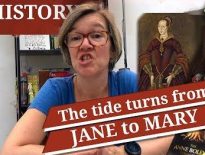On this day in Tudor history, 16th July 1546, in the reign of King Henry VIII, Protestant martyrs Anne Askew, John Lascelles, John Adams and Nicholas Belenian were burned at the stake at Smithfield in London for heresy.
Poor Anne had been illegally racked, so special provision had to be made for her execution.
In today's talk, I share an account of the ends of these courageous people, along with some trivia about one of them.
Also on this day in history:
- 1517 – Birth of Frances Grey (née Brandon), Duchess of Suffolk, at Hatfield. She was born on St Francis's Day and was the eldest daughter of Charles Brandon, Duke of Suffolk, and Mary Tudor, widow of Louis XII and sister of Henry VIII.
- 1556 – Burnings of Julins Palmer, John Gwyn, and Thomas Robyns [some sources say Askew or Askin] in the old sandpits in Enborne Road, Newbury, after they were found guilty of sedition and heresy. They are known as the Newbury Martyrs.
- 1557 – Death of Anne of Cleves, fourth wife of Henry VIII, at Chelsea Old Manor after a few months of illness. On the same day, her body was embalmed and placed in a coffin covered with a cloth bearing her arms. Tapers were lit around her coffin and prayers said on a daily basis. She was buried in Westminster Abbey on 4th August.
- 1574 – Death of John Hart, scholar, phonetician and Chester Herald, in London.
- 1600 – Death of George Cranmer, scholar, administrator and nephew of Thomas Cranmer, the late Archbishop of Canterbury, in a skirmish with Irish rebels at Carlingford. He was in Ireland serving Charles Blount, Lord Mountjoy, as Secretary during a military campaign.



What a terrible ordeal, poor lady. Bad enough that people were burnt but torturing was illegal without a warrant in any event and not normal in heresy trials but certainly not for a woman. The King officially didn’t give his consent but she was racked and by Rich and Southampton themselves, again illegally. The reasons they used was to get names as they wanted to know who was also in the Queen’s household who were heretics.
What a brave and heroic woman as were those with her. The men were not tortured but Anne was thought to have powerful friends helping her and it was them the Chancellor wanted to find.
I recently learned it was also illegal to rack someone in poor health or with a physical disability because they would possibly die or pass out, so not from compassion. However, Nicholas Owen was racked for six days despite having a hernia, which burst and he died from the torture. This was the man who built all of the priest holes and the government were keen to find out were they were. Again, a horrible way to go.
You couldn’t win in Tudor England. If you were a heretic or Protestant or reformer you were burnt at the stake. If you disagree with the Supremacy under Henry Viii you were hanged drawn and quartered and if you were Catholic under Elizabeth and James the same fate awaited. No wonder some people tried to get rid of them.
These people are all very brave. Most people would conform. It was the only way to survive in a nutty regime like the Tudors and Stuarts.
RIP Anne Askewe and friends.
A very brave woman
I’ve been to St. Bartholomew Church and it’s amazing so full of history . I’ve enjoyed the chat Claire and the reply from Tudor Lady